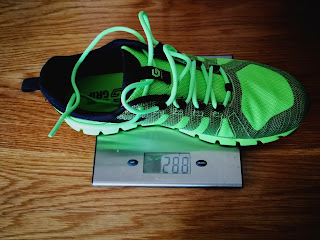This is an interesting one.
I tend to have a bias towards more minimal footware and part of this is probably because I'm relatively light, so a shoe that may feel minimal to a heavier runner could still feel like it has plenty of cushion to me. Regardless, I had signed up to my biggest race challenge yet; Les Traces des Duc de Savoie (TDS) and I decided to listen to the common advice from my more experienced ultra running friends and go maximal. The Hoka Evo Mafate was the shoe that I settled on.
Stoat Rating: 7/10
Weight: 300g in UK 8.5
Sizing: True to size
Overview
This is the first maximal shoe that I have really enjoyed. The midsole is snappy and responsive without any of that mushyness that a lot of Hokas other maximal shoes that I have tried have. However, I had issues with blisters when running anything further than ~marathon distance. These seemed to be due to the 'bucket seat' shape of the midsole where the 'sides' of the midsole bucket rubbed on the side of my feet where they curve up to create a 'wall'. This was particularly noticeable on the inside of my big toe due to the taper of the toebox which doesn't match the geometry of my my feet (or any normal feet as far as I can see). Ultimately this means that the shoe isn't great for ultra distances for me at least, which is a shame as I loved the general feel of the midsole.
Upper
The shoe is a narrow fit at the front with a pronounced taper on both the inside and outside of the toebox; this widens to a moderate fit at the heel. There is a little more room than the Hoka Speedgoat2, but the shoe is not very tolerant to different foot shapes due to the upper being very inelastic and the midsole having the 'bucket seat'. This means that if you fit the mould then they are probably great, but if you don't, then they won't conform much to your foot shape.
Midsole
A huge slab of foam which surprised me by providing an elastic / springy toe off without the mushyness that I have hated in past Hokas (notably the speedgoat2 which I ran in quite a bit). As someone who generally prefers more minimal shoes I have a hard time in admitting that I loved the midsole, and in spite of having fit problems that make this shoe painful for ultra distances, I have used it quite a bit on shorter trail races where they do well on a mix of terrain from hardpacked / rocky to quite soft.
My only significant complaint on the midsole is that I think that the bucket seat shape was the cause of blisters on the sides of my toes and heel. I think that this was also accentuated by the complex shaping of the midsole where the outer edge seems to be hinged such that it could lever up and pinch the foot. This seemed to be an intentional design feature which I guess is intended to provide a more secure foot grip, but I'm not sure how much of a benefit this is in practice and it certainly seemed to worsen the blisters for me. I also found that the arch was a little high and caused me some irritation - this was solved by putting in some Nike insoles which taper at the edges and counteracted the high arch. The photo below you can see my big toe distorting the upper inward outside of the outsole.
Outsole
The lugs were quite pronounced when new and provided good traction on the muddy terrain of TDS, but also ran well on the road. The only downside was that they have lost height over time as there are relatively few lugs overall and limited contact surface area. As a consequence, I assumed that the outsole would not last long, but in practice I have put 300km on them and so far they are holding up OK with about 25% of the height lost.
Aesthetics
I like them. I tend to prefer a simple colour scheme and I think that they deliver. There is a second colour with an orangy red at the front of the shoe if you want something a bit brighter.
What I'd change
The shape of the toebox doesn't work for me, and to be honest the taper on the inside is simply not the shape of a normal human foot. If this were straighter then I think the shoes would fit much better and, for me, would be superb for long ultras in difficult terrain. I would probably also personally loose 5mm of stack height as I think that I would benefit from the tradeoff of cushion for stability, however, for heavier runners I suspect the tradeoff is about right.
All of this makes me want to try the Challenger ATR5 which looks to fix all these problems, but the outsole looks a bit more limited to tamer terrain.
Final thoughts
Nearly amazing - I love the feel of the midsole which combines a springy feel with ample protection for the long haul. The outsole is great on a range of surfaces albeit it that it won't be the most long lasting. The shoe is ultimately let down by it's fit, and given the in-elasticity of the upper and the bucket seat midsole, it is not tolerant of different foot shapes.



















